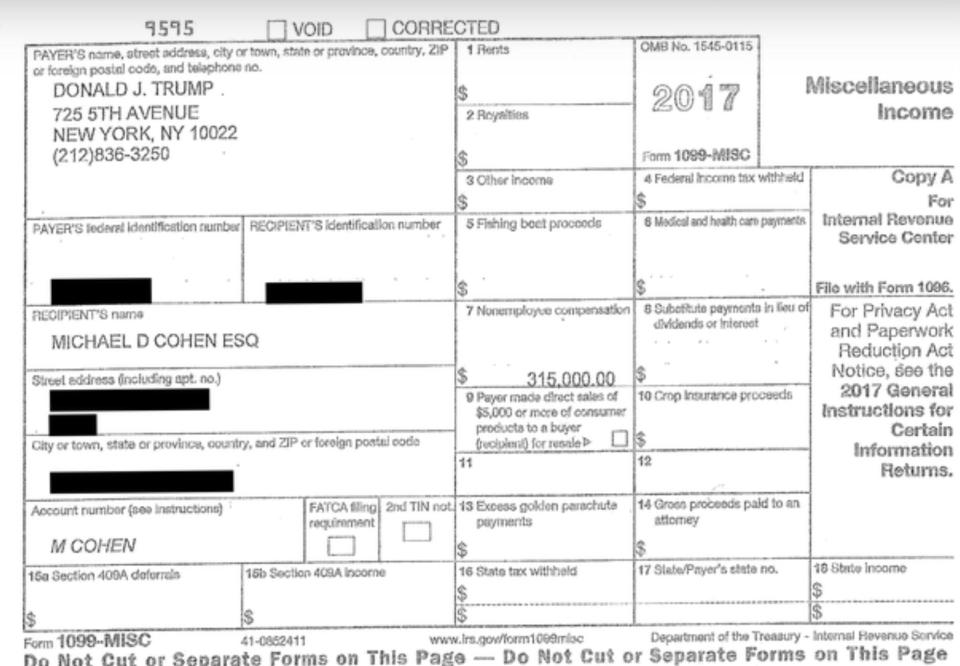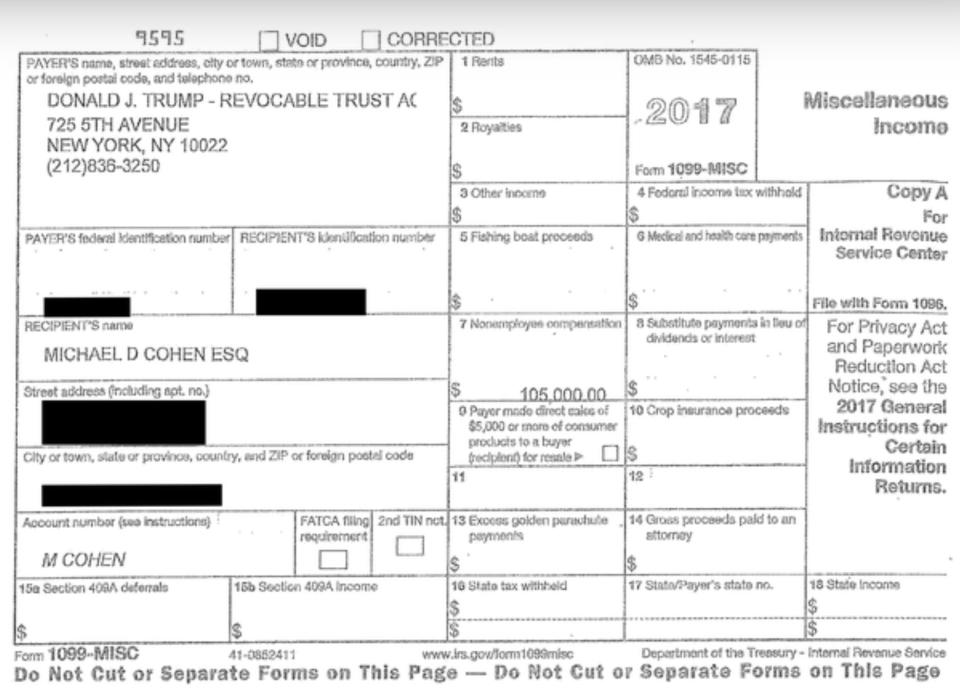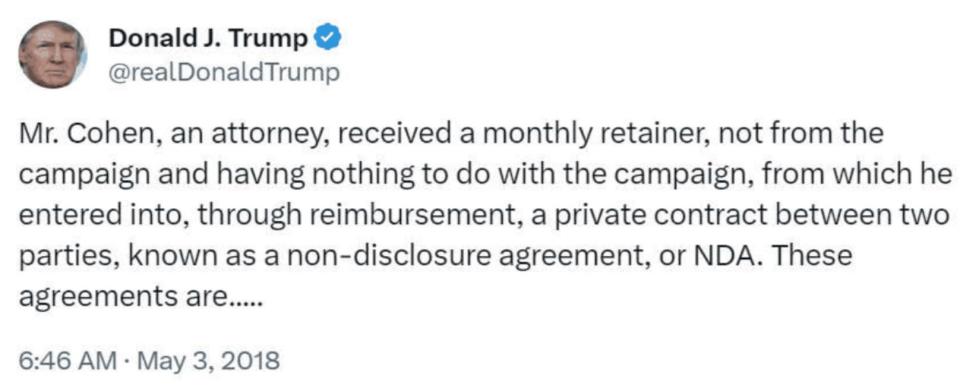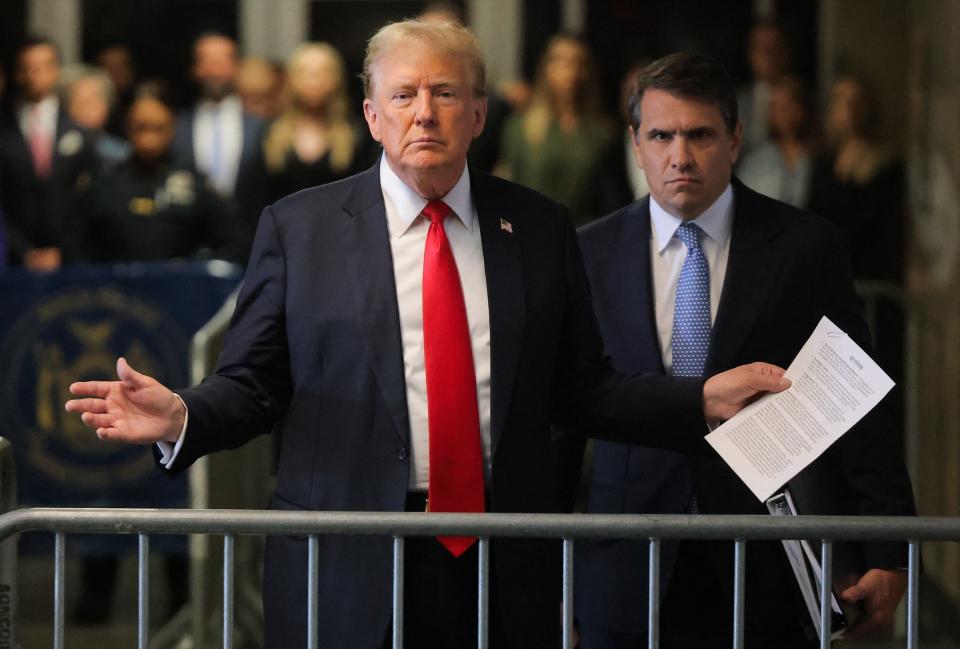In a baffling closing argument, Trump attorney Todd Blanche used DA's evidence against his own client
In closings Tuesday, Trump's lawyer Todd Blanche tried the classic "but if he did do it" defense.
If Trump did falsify documents, he didn't do it with the required criminal intent, Blanche argued.
He showed jurors three prosecution exhibits where Trump acknowledged the hush-money reimbursement.
It's the classic defense closing argument: My client didn't do it, ladies and gentlemen — but if he did do it, it wasn't intentional.
This is the argument that former President Donald Trump's lawyer Todd Blanche tried out Tuesday on the hush-money jury in Manhattan.
Yes, Blanche spent the bulk of his arguments denying that Trump committed the crimes he's accused of.
Prosecutors say Trump falsified 34 business records to hide a year's worth of reimbursement payments to his then-attorney Michael Cohen, who had fronted a $130,000 hush-money payment to the porn star Stormy Daniels.
Trump was not involved in any such conspiracy to influence the 2016 election, Blanche told jurors Tuesday — during a three-hour summation where he walked them through a more than 180-part slideshow presentation ahead of the start of their deliberations on Wednesday.
But if he was involved, there was no intent to commit fraud, Blanche argued. How could there be, he asked, when Trump freely and repeatedly acknowledged reimbursing Cohen?
Blanche then showed the jury three exhibits from the prosecution's case.
The exhibits — showing a tax form, a tweet, and a government ethics form — were shown on the courtroom's display screens.
Each bolsters the prosecution's case: Trump knew full well that the $130,000 he paid Cohen in installments throughout 2017 was for reimbursement, not legal fees, as his business-record entries falsely claimed.
"The government has to prove to you that President Trump caused these entries — even if they were false — with an intent to defraud," Blanche told jurors.
"Where is the intent to defraud on the part of President Trump?" the lawyer asked the jury.
Prosecutors must demonstrate Trump had an intent to defraud in order for them to prove first-degree falsifying of business records, which Trump is accused of doing 34 times throughout 2017, including when he personally signed nine of Cohen's reimbursement checks.

In his own closing argument, Joshua Steinglass, an assistant district attorney, said Trump had to have approved the reimbursement scheme.
Cohen would never have fronted the $130,000 without his micromanaging boss' preapproval and guarantee of repayment, Steinglass argued.
"Michael Cohen had 130,000 reasons to get Mr. Trump's sign-off," the prosecutor told jurors.
During his closing argument, Blanche angered the judge by telling jurors that "you cannot send somebody to prison based on what Michael Cohen is saying."
Jurors are supposed to weigh only the facts in their deliberations — not the potential punishment.
"That was outrageous, Mr. Blanche," Justice Juan Merchan of the New York Supreme Court told Blanche after jurors were dismissed for lunch.
"Someone who's been a prosecutor as long as you have, and a defense lawyer as long as you have, knows it's highly inappropriate," the judge said.
"It's simply not allowed, period," the judge added. He gave a curative instruction to the jury, saying that Blanche's comment was "improper" and that if Trump was convicted, "a prison sentence is not required." Falsifying business records carries a sentence of anywhere from zero jail to four years in prison.
Here are the three exhibits that Blanche displayed for jurors as "proof" that Trump had nothing to hide and therefore could not have intended to defraud anyone.
But each is highly incriminating of Trump, prosecutors have argued.
1. A 1099 tax form from 2017
The Trump Organization — and Trump as an individual — reported that it paid Cohen a total of $420,000 in income in 2017.
Prosecutors say this is the sum Trump's then-CFO, Allen Weisselberg, calculated would be reimbursed for Cohen's hush-money outlay, plus taxes and other money Trump owed him.
Why would Trump announce to the IRS "if there was some deep-rooted intent to defraud on the part of President Trump?" Blanche asked jurors.


But the 1099s are "false," Steinglass, the prosecutor, told jurors in his closing arguments, which went on for five hours, ending at 8 p.m.
The 1099s demonstrate that Trump "filled out phony forms" to report income for Cohen that did not exist, Steinglass said — "because it wasn't income; it was reimbursement."
2. A 2018 tweet
On May 3, 2018, Trump posted a somewhat garbled tweet that said the payments he'd made to Cohen throughout 2017 were, in his word, "reimbursement."

This tweet was posted just five months after Trump signed the last of nine $35,000 checks to Cohen. Each check was labeled "RETAINER."
3. A government ethics form
Finally, during closing arguments, Blanche showed jurors what's called an Executive Branch Personnel Public Financial Disclosure Report for the year 2017. This was the then-president's mandatory disclosure of his assets and liabilities.
Under "Liabilities" — which is the section where Trump must list the money he's borrowed — Trump certified that in 2017, he "fully reimbursed" Cohen an interest-free sum of between $100,000 and $250,000.

"President Trump tweeted what happened when it came out" and then signed a government ethics form that also acknowledged the reimbursement, Blanche told jurors Tuesday.
"That's not evidence of any intent to defraud," Blanche said.
But prosecutors have argued this form shows Trump knew the money he paid Cohen was reimbursement for money lent — the Daniels hush money.
Cohen the 'GLOAT'
Blanche spent most of his summation impugning the credibility of Cohen, whose testimony is key to the prosecution case.
Cohen is "literally like an MVP of liars," the defense lawyer told jurors. Two jurors — a woman in the front row and a man in the back row — smiled when Blanche went on to call Cohen "the GLOAT," for "greatest liar of all time."
The district attorney's reliance on Cohen's testimony demonstrates the weakness of the prosecution's case, Blanche said. He said that Cohen committed "per-ju-ry" — stressing every syllable — on the witness stand and was "the human embodiment of reasonable doubt."
"You should want and expect more than the testimony of Michael Cohen," he said.

Blanche sidestepped the most pivotal documents in the case, handwritten notes from Weisselberg and the Trump Organization's then-comptroller, Jeffrey McConney, that appeared to explain how Cohen would be repaid for hush money in $35,000 payments, including a "gross up" to cover taxes.
Blanche claimed that if the document was truly proof of an illegal conspiracy, the Trump Organization would have destroyed it instead of keeping it in a filing cabinet — from which they were ultimately turned over to prosecutors.
Steinglass countered that it must have been hard for Blanche to make that argument "with a straight face," saying the illegal conspiracy was laid out "in the document itself."
"These documents are so damning that you almost have to laugh," he said.
At the beginning of the prosecution's closing argument on Tuesday afternoon, Steinglass said that while Cohen may have a track record of dishonesty, he had come clean and "been consistently explaining the facts of this case for six years."
"We didn't choose Michael Cohen. We didn't pick him up at the witness store," Steinglass said. "The defendant chose Michael Cohen because of his willingness to lie."
Blanche had also criticized prosecutors for spending time teasing out testimony from Daniels, which he said wasn't critical to the criminal charges, related to falsified documents. Prosecutors, the defense lawyer said, just wanted to "embarrass" Trump.
Daniels' vivid and "cringeworthy" details "ring true" and were "uncomfortable," which is why they were so important, Steinglass said. Trump wanted to cover up her story to influence the election, he added.
"That's kind of the point," Steinglass said. "That's the display the defendant didn't want the American people to see."
Trump didn't pay $130,000 to cover up a photo of him and Daniels on a golf course — but to cover up a scandal, Steinglass said.
"Stormy Daniels is the motive," he said.
Read the original article on Business Insider


